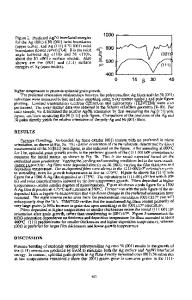IOn Energy and Dose Effects During Ion-Assisted Epitaxial Growth of InAs on Si(100)
- PDF / 435,465 Bytes
- 6 Pages / 420.48 x 639 pts Page_size
- 16 Downloads / 343 Views
ION ENERGY AND DOSE EFFECTS DURING ION-ASSISTED EPITAXIAL GROWTH OF InAs ON SM(OO) C.-H. CHOI AND S.A. BARNETT Department of Materials Science and Engineering and the Materials Research Center, Northwestern University, Evanston IL 60208 ABSTRACT Epitaxial InAs films have been grown on Si(100) substrates using triode The ratio r of the impinging Ar ion flux J ion-assisted deposition (TRIAD). to the deposited InAs flux was varied from 2.5 to 8.5 for Ar ion energies E from 5 to 55 eV . The growth temperature T was 350 0 C while the growth rate R was fixed at 0.6 pm/h. Two types of experiments were carried out. First, in order to investigate ion damage effects, X-ray diffraction rocking curve full-widths at half-maximum (FWHM) were measured as a function of E and r. In these experiments, the first 50 nm of InAs was always grown under the same conditions, r = 5 and E = 25 eV, in order to eliminate possible complicating effects caused by ion irradiation during InAs nucleation on Si, followed by 550 nm of growth at different E and r values. FWHM values increased with increasing E and r from 2800 arcsec, a value limited by defects arising from the 11% mismatch between InAs and Si, to 8900 arcsec as a result of ion The FWHM value was found to be dependent on the total number of damage. atomic displacements due to ion irradiation, estimated using a modified Kinchin-Pease expression. In the second set of experiments, E during the first 50 nm of growth was varied while ion irradiation damage in the remaining 5500 nm was minimized. Increasing E from 15 to 40 eV resulted in a decrease in the FWHM from 5500 to 2600 arcsec, followed by a gradual increase when E was increased above 40 eV. Ion irradiation at the onset of film growth thus reduced the propagation of defects from the InAs/Si interface into the film. INTRODUCTION The use of low energy ion bombardment during epitaxial growth has attracted considerable interest due to beneficial effects of ion-surface interactions. For example, low-energy irradiation (where low can be roughly defined as < 200 eV) has been used to decrease epitaxial temperatures,[1-4J decrease defect densities,[5,6] increase do pant incorporation probabilities,[7-10] decrease dopant segregation, [10] increase P and As incorporation probabilities during growth of III-V alloys,[11,12] and allow the growth of a range of metastable alloys [13,14]. In addition, ion sputtering is an important technique for cleaning surfaces prior to epitaxial growth [15,16]. The successful application of ion-assisted semiconductor growth requires that ion damage be avoided or minimized. However, the understanding of the complex, depth-dependent collisional and thermal processes at the surface of a growing film - point defect production, defect diffusion, defect annihilation, and agglomeration of point defects into stable extended defects In the results described above, such as dislocation loops - is incomplete. ion damage was usually negligible for ion energies E < 200 eV. Increasing E above a critical value, which may depend on
Data Loading...









